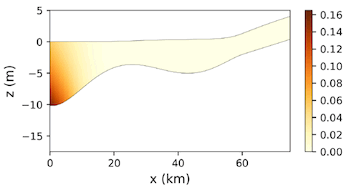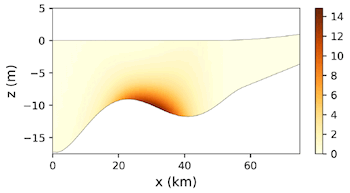R.J.A. de Goede1,2*, Y.M. Dijkstra1, B.C. van Prooijen1, Z.B. Wang1,2
1 Delft University of Technology,2 Deltares
*
Introduction
A study of five European estuaries by Winterwerp and Wang (2013) showed that tidal ranges increased significantly along with the ongoing narrowing and deepening of these estuaries. In addition to an increase in tidal range, a dramatic increase in suspended sediment concentrations has been observed in the Ems (Germany) and Loire (France) estuaries, often referred to as a regime shift towards hyperturbid state. While it is generally accepted that the increase in tidal range is a consequence of deepening and narrowing, it is not generally true that deepening and narrowing leads to a dramatic increase in sediment concentrations. Whether deepening is a potential cause for the high sediment concentrations observed in the Loire, is still unclear.
Methods
Although very little observations have been reported over the 20th century, literature clearly shows that sediment concentrations increased drastically over the years. The scarcity of data not only applied for the sediment concentrations over the years but also for bathymetry and hydrodynamics, resulting in uncertainty about the historical states of the estuary. To cope with the large range of uncertainty and variability in the reported observations and model parameters, an idealised model called iFlow has been used. The strength of the iFlow model for this research was twofold. Firstly, iFlow allowed to identify the essential physical processes driving the estuarine sediment dynamics. Secondly, iFlow is computationally efficient, allowing to perform extensive sensitivity studies. In this way, we could determine which processes play a role in the current state of the Loire estuary and how they are affected by deepening. Furthermore, by mapping the effects of the uncertainty on the different physical processes, robust conclusions could be drawn about the effects of deepening, despite the given uncertainty in the input and simplifications of the iFlow model.
Results
The effects of deepening on the physical processes has been assessed by only varying the depth in the model. Deepening generally resulted in enhanced sediment import or decreased sediment export. Hence, the transport capacity in the Loire became much more favourable for the import of sediment. In order to determine the robustness of these findings, an extensive sensitivity study was performed of 14.157 simulations (1287 conditions for 11 bottom profiles over time) to capture the influence of uncertainties in multiple input parameters. For the bottom profile representing the bathymetry in the year 1900, none of the conditions resulted in a hyperturbid state, whereas independent of the conditions, the likelihood to find a hyperturbid state always increased for increasing depth. From this we can conclude, that the observed regime shift towards high sediment concentrations would not have happened without the deepening of the Loire estuary.


Figure 1 Modelled tidally averaged suspended sediment concentrations in (kg/m3) along the Loire estuary (x=0 is the mouth) for bottom profiles representing the bathymetries around the years 1900 (a) and 2010 (b). The drastic increase in sediment concentrations is found by only increasing the depth, keeping all other model parameters constant.
I. Surname1*, F.N. Another-Surname2 , Y. Next-Surname2
1 University Name, Country; 2 Organization Name, Country
* Corresponding author: mail.name@organization.org


